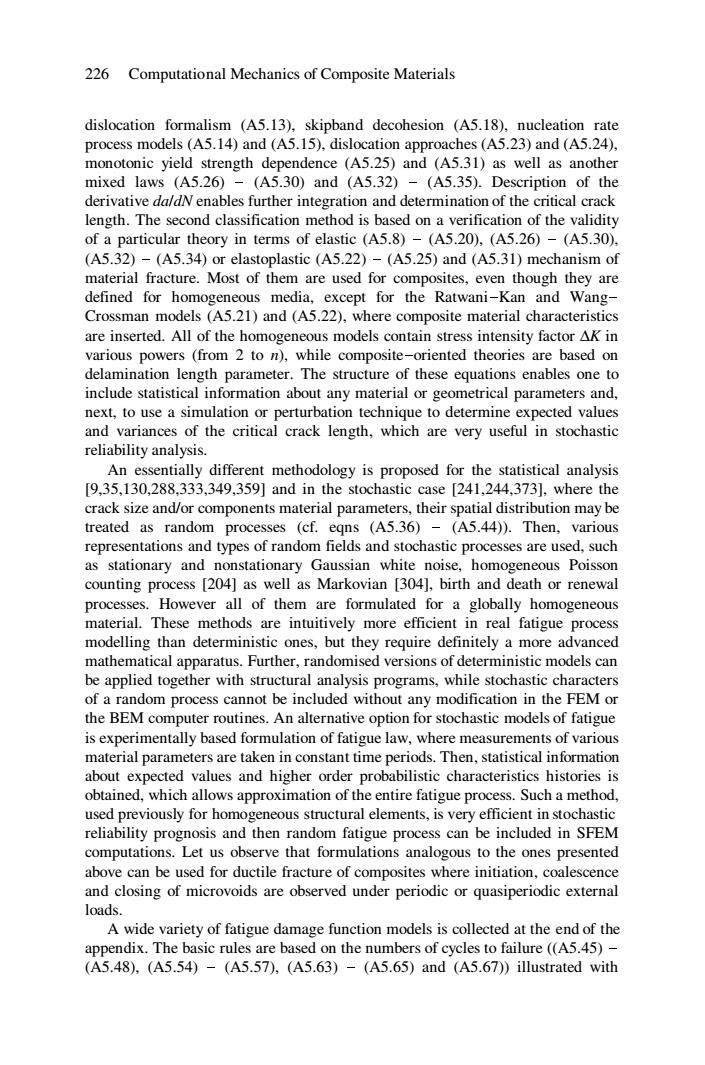正在加载图片...

226 Computational Mechanics of Composite Materials dislocation formalism (A5.13),skipband decohesion (A5.18),nucleation rate process models (A5.14)and(A5.15),dislocation approaches (A5.23)and(A5.24), monotonic yield strength dependence (A5.25)and (A5.31)as well as another mixed laws (A5.26)-(A5.30)and (A5.32)-(A5.35).Description of the derivative da/dN enables further integration and determination of the critical crack length.The second classification method is based on a verification of the validity of a particular theory in terms of elastic (A5.8)-(A5.20),(A5.26)-(A5.30), (A5.32)-(A5.34)or elastoplastic (A5.22)-(A5.25)and (A5.31)mechanism of material fracture.Most of them are used for composites,even though they are defined for homogeneous media,except for the Ratwani-Kan and Wang- Crossman models (A5.21)and (A5.22),where composite material characteristics are inserted.All of the homogeneous models contain stress intensity factor AK in various powers (from 2 to n),while composite-oriented theories are based on delamination length parameter.The structure of these equations enables one to include statistical information about any material or geometrical parameters and, next,to use a simulation or perturbation technique to determine expected values and variances of the critical crack length,which are very useful in stochastic reliability analysis. An essentially different methodology is proposed for the statistical analysis [9,35,130,288,333,349,359]and in the stochastic case [241,244,373],where the crack size and/or components material parameters,their spatial distribution may be treated as random processes (cf.egns (A5.36)-(A5.44)).Then,various representations and types of random fields and stochastic processes are used,such as stationary and nonstationary Gaussian white noise,homogeneous Poisson counting process [204]as well as Markovian [304],birth and death or renewal processes.However all of them are formulated for a globally homogeneous material.These methods are intuitively more efficient in real fatigue process modelling than deterministic ones,but they require definitely a more advanced mathematical apparatus.Further,randomised versions of deterministic models can be applied together with structural analysis programs,while stochastic characters of a random process cannot be included without any modification in the FEM or the BEM computer routines.An alternative option for stochastic models of fatigue is experimentally based formulation of fatigue law,where measurements of various material parameters are taken in constant time periods.Then,statistical information about expected values and higher order probabilistic characteristics histories is obtained,which allows approximation of the entire fatigue process.Such a method, used previously for homogeneous structural elements,is very efficient in stochastic reliability prognosis and then random fatigue process can be included in SFEM computations.Let us observe that formulations analogous to the ones presented above can be used for ductile fracture of composites where initiation,coalescence and closing of microvoids are observed under periodic or quasiperiodic external loads. A wide variety of fatigue damage function models is collected at the end of the appendix.The basic rules are based on the numbers of cycles to failure ((A5.45)- (A5.48),(A5.54)-(A5.57),(A5.63)-(A5.65)and(A5.67)illustrated with226 Computational Mechanics of Composite Materials dislocation formalism (A5.13), skipband decohesion (A5.18), nucleation rate process models (A5.14) and (A5.15), dislocation approaches (A5.23) and (A5.24), monotonic yield strength dependence (A5.25) and (A5.31) as well as another mixed laws (A5.26) - (A5.30) and (A5.32) - (A5.35). Description of the derivative da/dN enables further integration and determination of the critical crack length. The second classification method is based on a verification of the validity of a particular theory in terms of elastic (A5.8) - (A5.20), (A5.26) - (A5.30), (A5.32) - (A5.34) or elastoplastic (A5.22) - (A5.25) and (A5.31) mechanism of material fracture. Most of them are used for composites, even though they are defined for homogeneous media, except for the Ratwani-Kan and WangCrossman models (A5.21) and (A5.22), where composite material characteristics are inserted. All of the homogeneous models contain stress intensity factor ∆K in various powers (from 2 to n), while composite-oriented theories are based on delamination length parameter. The structure of these equations enables one to include statistical information about any material or geometrical parameters and, next, to use a simulation or perturbation technique to determine expected values and variances of the critical crack length, which are very useful in stochastic reliability analysis. An essentially different methodology is proposed for the statistical analysis [9,35,130,288,333,349,359] and in the stochastic case [241,244,373], where the crack size and/or components material parameters, their spatial distribution may be treated as random processes (cf. eqns (A5.36) - (A5.44)). Then, various representations and types of random fields and stochastic processes are used, such as stationary and nonstationary Gaussian white noise, homogeneous Poisson counting process [204] as well as Markovian [304], birth and death or renewal processes. However all of them are formulated for a globally homogeneous material. These methods are intuitively more efficient in real fatigue process modelling than deterministic ones, but they require definitely a more advanced mathematical apparatus. Further, randomised versions of deterministic models can be applied together with structural analysis programs, while stochastic characters of a random process cannot be included without any modification in the FEM or the BEM computer routines. An alternative option for stochastic models of fatigue is experimentally based formulation of fatigue law, where measurements of various material parameters are taken in constant time periods. Then, statistical information about expected values and higher order probabilistic characteristics histories is obtained, which allows approximation of the entire fatigue process. Such a method, used previously for homogeneous structural elements, is very efficient in stochastic reliability prognosis and then random fatigue process can be included in SFEM computations. Let us observe that formulations analogous to the ones presented above can be used for ductile fracture of composites where initiation, coalescence and closing of microvoids are observed under periodic or quasiperiodic external loads. A wide variety of fatigue damage function models is collected at the end of the appendix. The basic rules are based on the numbers of cycles to failure ((A5.45) - (A5.48), (A5.54) - (A5.57), (A5.63) - (A5.65) and (A5.67)) illustrated with